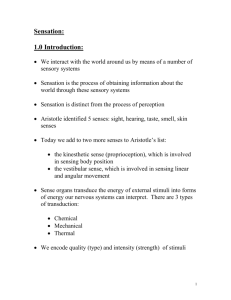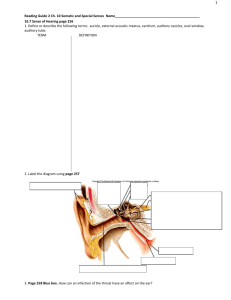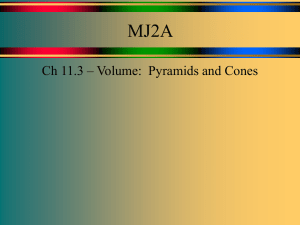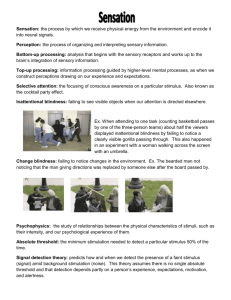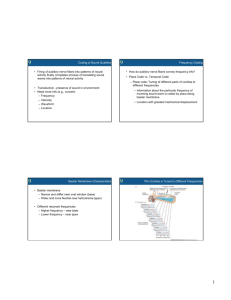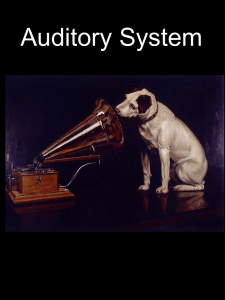Chapter 3
advertisement
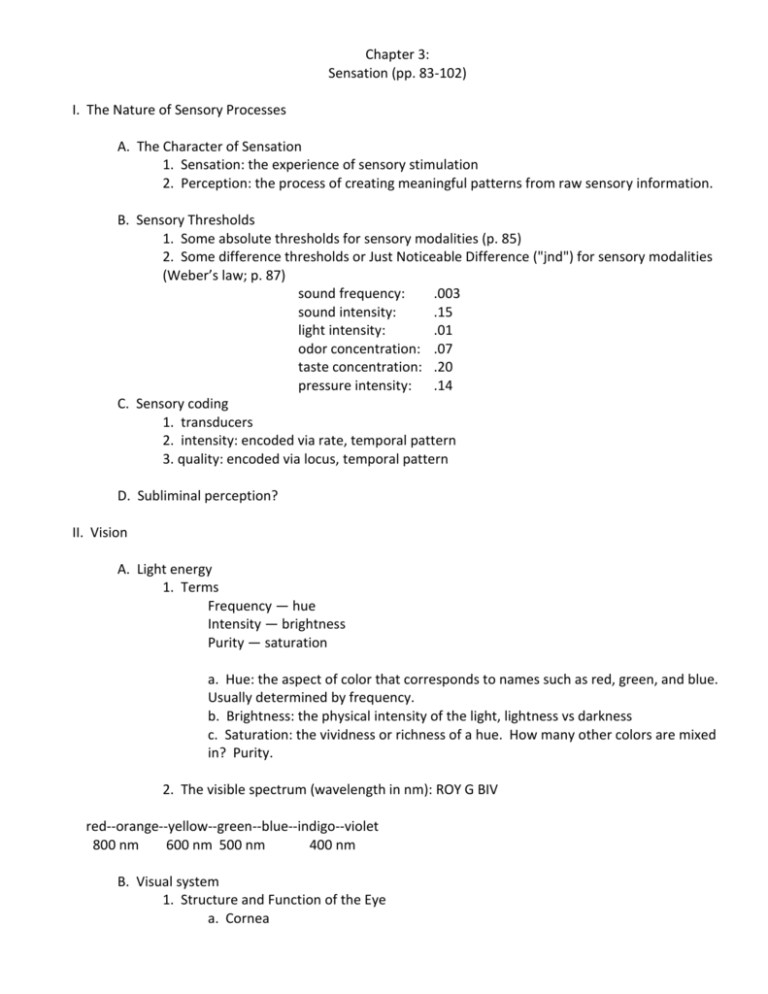
Chapter 3: Sensation (pp. 83-102) I. The Nature of Sensory Processes A. The Character of Sensation 1. Sensation: the experience of sensory stimulation 2. Perception: the process of creating meaningful patterns from raw sensory information. B. Sensory Thresholds 1. Some absolute thresholds for sensory modalities (p. 85) 2. Some difference thresholds or Just Noticeable Difference ("jnd") for sensory modalities (Weber’s law; p. 87) sound frequency: .003 sound intensity: .15 light intensity: .01 odor concentration: .07 taste concentration: .20 pressure intensity: .14 C. Sensory coding 1. transducers 2. intensity: encoded via rate, temporal pattern 3. quality: encoded via locus, temporal pattern D. Subliminal perception? II. Vision A. Light energy 1. Terms Frequency — hue Intensity — brightness Purity — saturation a. Hue: the aspect of color that corresponds to names such as red, green, and blue. Usually determined by frequency. b. Brightness: the physical intensity of the light, lightness vs darkness c. Saturation: the vividness or richness of a hue. How many other colors are mixed in? Purity. 2. The visible spectrum (wavelength in nm): ROY G BIV red--orange--yellow--green--blue--indigo--violet 800 nm 600 nm 500 nm 400 nm B. Visual system 1. Structure and Function of the Eye a. Cornea b. Pupil c. Iris d. Lens e. Retina f. Receptor Cells (1) Rods (2) Cones: B, G, R g. Fovea (cones, no rods) h. Blind spot (neither rods nor cones) 2. The Receptor Cell: Photoreceptors and associated neural systems a. 120 million rods b. 8 million cones c. Other cell: bi-polar, horizontal, ganglion, amacrine cells d. 1 million ganglion cells 3. Visual Pathways: Eye to Brain a. Interneurons b. Optic Nerve c. Optic chiasm d. Lateral geniculate nucleus in thalamus e. Occipital cortex 4. Miscellaneous visual phenomena a. projection areas in different areas of visual cortex, feature detectors b. Glaucoma III. Color vision A. How to produce different colors 1. Additive color mixture: mixing lights of different wavelengths together to create new hues 2. Subtractive color mixture: mixing paints/pigments each of which absorbs some wavelengths of light and reflects others *3. Also possible to produce colors by rapidly spinning a disk with different sections of black/white B. Tri-chromatic theory of color vision 1. Young (1802), Helmholtz (1850), and subsequently modernized. 2. 3 kinds of cones in retina: B-G-R 3. Little or no neural processing occurs between the cones and the brain. 4. The way it explains some phenomena: a. Primary colors by rate of firing by one kind of cone. Other colors = different combination of cones: R + G => Y. b. If R - G color blind, deficit in R - G cones 5. Problems: a. How to account for negative afterimages? Color Negative afterimage yellow blue green red b. If R - G color blind because of deficit in R - G cones, and if R + G => Y, then shouldn't be able to see yellow--but can. C. Opponent Process Theory of color vision 1. Hering (1870), and subsequently modernized (Boynton, DeValois, Hurvich/Jameson). 2. 3 kinds of cones in retina: B-G-R 3. Much neural processing between cones and brain. Precise locations and nature of functions uncertain, probably involves bi-polar cells, horizontal cells, amacrine cells, ganglion cells, and lateral geniculate nuclei, as well as the occipital cortex. 4. Cells organized into 3 systems: a. R - G system b. B - Y system c. white - black system 5. Colors seen determined by rate of firing in each system, or combinations across systems 6. Phenomena it can explain a. Negative afterimages: “fatigue” in the system b. Color blindness: problem can be in either cones or appropriate system IV. Hearing A. Sound energy 1. Terms Frequency — pitch Intensity — loudness Purity — timbre/overtones a. Pitch: the aspect of sound that corresponds to names such as high or low. Usually determined by frequency. b. Loudness: the physical intensity of the sound. Amplitude. c. Timbre: How many other frequencies are mixed in? Purity. 2. Auditory system Frequency: 20 — 20,000 Hz Intensity: 0— 120 dB B. The Ear: Its Structure and Function 1. Structure of Ear a. Hammer, Anvil, Stirrup b. Oval Window c. Round Window d. Cochlea e. Basilar membrane f. Organ of Corti 2. Neural Connections a. Auditory Nerve b. Left/Right Connections: Hearing is Bilateral--each ear sends messages to both cerebral hemispheres. The switching station is in the medulla. 3. Hearing Disorders a. Hearing Loss (1) Impairment in Conduction (2) Damage to basilar membrane b. Hearing aids c. Cochlear Implants V. Pitch perception A. Some basic facts about auditory structures 1. Although the cochlea itself is widest near the oval window (the base end), the basilar membrane is thin and stiff near the base but wide and flexible at the other end of the cochlea (the apex). Because of this difference in width/flexibility, a given auditory frequency will produce a peak displacement of the basilar membrane that is greater at one location than at others, within certain limits. Peak displacement means region of greatest vibration. High frequencies produce peak displacement toward the oval window end Intermediate frequencies produce peak displacement in the center region 2. But lower frequencies (below about 200 Hz) produce approximately uniform displacement of the basilar membrane, from the center region to the apex. 3. For auditory frequencies from 20 Hz to about 4,000 Hz, the frequency of firing in the auditory nerve equals the auditory frequency of the incoming sound. B. Place Theory of hearing 1. Pitch is determined by the region of maximum displacement. 2. But what about frequencies below 200 Hz? C. Temporal/ Frequency Theory of hearing 1. Pitch is determined by frequency of firing in auditory nerve: a. Slow firing = low pitch b. Faster firing = higher pitch (up to 3-4,000 Hz) 2. No single cell can fire fast enough to keep up with an incoming sound of 3-4,000 Hz. 3. Volley theory [Volley Principle] a. Cells must be organized into squads and fire in volleys (volley principle). b. modified Frequency Theory 4. Overall Theory: Summary a. For frequencies from 20 Hz to 200 Hz, principles of frequency theory usually accepted. b. For frequencies from 3-4,000 Hz to 20,000 Hz, principles of place theory usually accepted. c. For frequencies from 200 Hz to 3-4,000 Hz, principles of both theories are thought to operate.
